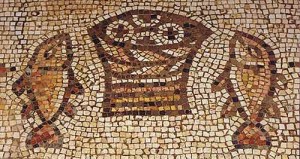 17th Sunday in Ordinary Time – Cycle B
17th Sunday in Ordinary Time – Cycle B
From Emptiness to Abundance (Jn 6:1-15)
Which is the only miracle of Jesus (besides the healing of the blind man – with differences in detail!) that is narrated in all the four gospels with similar details? It is the miracle of feeding the five thousand from five loaves, which we hear in the gospel of this Sunday.
From Mark to John
For Sunday readings of this year, being Cycle B, we follow the Gospel of Mark. In the past two Sundays we have been listening to the first part of chapter 6 of Mark. Following that sequence today we should have listened to the feeding of the five thousand according to Mark (Mk 6:35-44). However, the arrangement of the liturgical readings (the lectionary) makes a jump to the Gospel of John narrating to us the same story of feeding the five thousand (Jn 6:1-15). Through next six Sundays we will exhaust the whole chapter 6 of John reflecting on the discourse on the Bread of Life.
Several thoughts can be drawn from the gospel text of this Sunday. Being consistent with one of the major themes of the Gospel of John, let me focus on “abundance” – more precisely, on the theme of abundant life, which is also related to new creation and eternal life.
Before Jesus begins to act: emptiness
Just as in the miracle of the wedding at Cana (Jn 2:1-11), in this story of multiplication of loaves (Jn 6:1-15) there is a clear contrast between two states of affairs: a before and an after – before Jesus acts and after Jesus acts. There is a contrast between a state of emptiness and a state of abundance. There is a contrast between chaos (Greek for void and dark) and cosmos (Greek for order and whole world).
At the wedding at Cana (Jn 2:1-11) where Jesus turned water into wine, before Jesus was recognised, there was emptiness: six empty water jars, and they had no wine, the celebration had come to a standstill! When Jesus’ hour had dawned, the jars were filled up to the brim – making up a total of 180 gallons of best quality wine (that is, in US gallons, 681 litters; and in Imperial gallons, 818 litres).
In the gospel story of today, again, there is this strong contrast. Philip is very problem-focused in answering the pensive question of Jesus, “Where can we buy some bread for these people to eat?” Philip suffers from a scarcity mentality, as most of us do. He thinks only money can buy the bread. Even two-hundred days’ wage is not going to be enough. Realistic, may be; but notice that Jesus’ question is “where” and not “how much would it cost”. Where does this tweak in the focus between the source of the bread and the cost of the bread come from in the mind of Philip? It is simply a focus on problem, impossibility, and scarcity – an inability to focus on possibilities in the presence of Jesus.
Oh yes, we need to appreciate the initiative of Andrew in bringing people to Jesus: he brings Simon, his brother, to Jesus (Jn 1:41-42); elsewhere it would be Philip and Andrew who would bring the Greeks to Jesus (Jn 12: 20-22); and in the gospel story of today, Andrew brings the little boy to Jesus. However, pay attention what he says to Jesus even as he does this good act, “Here is a small boy with five barley loaves and two fish; but what is that among so many?” (Jn 6:9). The boy is referred to as being ‘small’ –an exaggerated diminutive expression; and again the focus is on the limitation of possibility: that the five loaves and two fish, after all, are nothing!
When Jesus begins to act: Abundance!
Jesus begins to act. Jesus is not going to be bogged down in impossibilities. There are five loaves and two fish (v.9). They add up to seven – a symbol of perfection and completeness; a symbol of creation – new creation! “There was plenty of grass there” (v.10b): it is spring time. There is going to be a new lease of life. “And as many as five thousand men sat down” (v.10c). Let us note that in the Semitic cultures, as is the case among most African peoples up to this day, counting heads of human beings is a taboo. So, surely, no one went around counting how many people really benefited from the miracle. Five stands for the Torah, so ‘five thousand’ could simply mean a countless number of Jews.
The theme of abundance continues: “… they had eaten enough” (v. 12). In Swahili we say, “walishiba” – it means, they were full-up! Remember the image of “up to the brim” at the wedding at Cana! The food was enough and more! “They picked them up and filled twelve large baskets with scraps left over from the meal of five barley loaves” (v.13). They filled! Twelve large baskets! See the contrast to the language of Philip and Andrew earlier in the story!
Yes, Jesus stands for abundance! The miracle of abundance of wine at Cana, and the miracle of abundance of bread on the hillside by the shores of Galilee are precursors to what Jesus would declare in the Gospel of John, “I have come so that they may have life and have it to the full” (Jn 10:10b).
Are we ready to be satisfied by his fullness? Are we ready to abandon our scarcity-mentality and embrace his abundance? Are we ready to transit from chaos to cosmos?